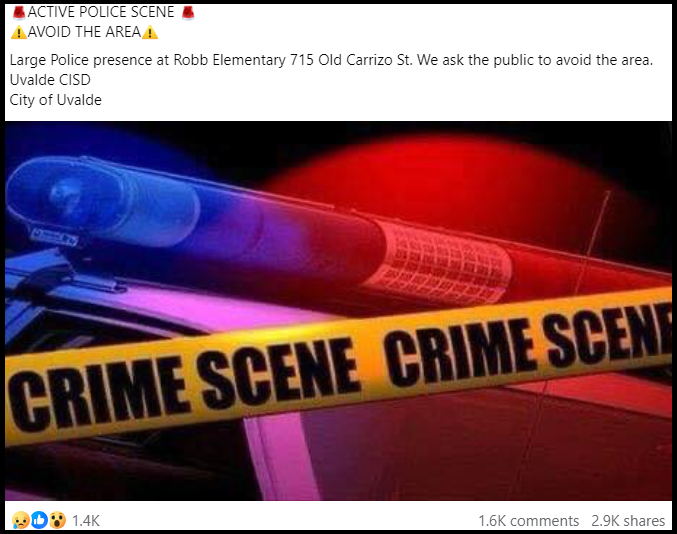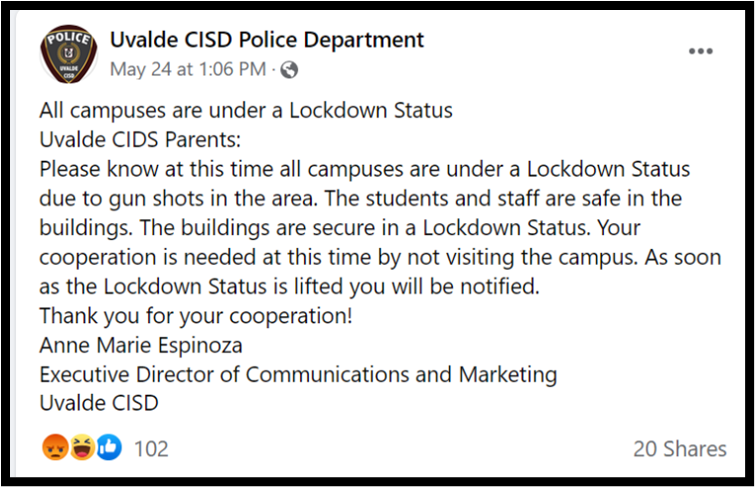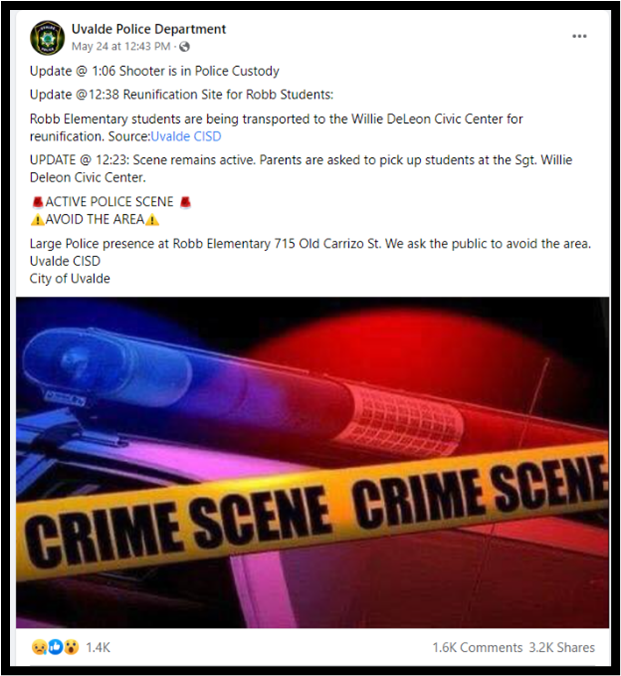Contact Us
To provide feedback on the Community Policing Dispatch, e-mail the editorial board at CPDispatch@usdoj.gov.
To obtain details on COPS Office programs, publications, and resources, contact the COPS Office Response Center at 800-421-6770 or AskCopsRC@usdoj.gov

U.S. Department of Justice
Office of Community Oriented Policing Services
Washington, DC 20530
When major events impact a community’s sense of safety and security, it is essential for law enforcement leaders to quickly restore calm and order. We have seen this happen with many large-scale incidents such as mass shootings, officer-involved shootings, and demonstrations that tipped over into civil unrest. However, this concept is often not intuitive for many law enforcement agencies, which operate on the premise that information must be held close to the vest to protect the integrity of an investigation.
These ideas must be balanced to ensure a thorough investigation while keeping the public informed, reassured, and safe.
If an agency establishes a pattern of releasing information about daily policing activities in a transparent and accountable manner, it becomes second nature to do so when communication is imperative—during a critical incident. When people are concerned or fearful about their safety, they are looking for leadership and direction. This is an opportunity for a law enforcement leader to unite the community and help them respond and recover from the incident.
A community should know it can rely on a department to be open and forthcoming with facts whether the situation is good, bad, or ugly for the agency. Consistency is vital for building community trust. People will judge the department and its leadership on how it handles the incidents and how it communicates about them. Public communication during and after the devastating tragedy at Robb Elementary School in Uvalde, Texas, in May 2022 was devoid of this type of proactive, organized approach. The law enforcement agency that initially assumed control of public messaging chose to release very limited information, and much of it proved to be false.
The REACT blueprint provides organizations with a template for developing key messages to share with the community.
- R – Release the facts
- E – Express empathy, care, and concern
- A – Action the agency is taking to instill confidence
- C – Call to action for community members
- T – Thank and praise partners who assisted with the situation
A department may use all five steps or may only need a few of the steps to craft an appropriate public message that projects leadership and compassion while keeping the public informed of the basic details. This blueprint is effective whether a law enforcement leader is alerting the community to a threat to public safety or reassuring them that law enforcement has resolved the situation. It is highly beneficial for an agency to craft a series of REACT statements before a crisis strikes. The Public Information Office should compile a list of possible incidents based on the issues and challenges of the community. From that list, the Public Information Officer (PIO) can draft REACT statements that can be easily customized based on the specifics of an incident. These prepared statements can help an agency respond more quickly and in a more organized and proactive fashion.
R. Release the Facts
In Uvalde, the first attempt to release facts came from the City of Uvalde Police Department (UPD).1 While some of its officers were among the first on the scene, this department did not assume control of the incident.


Because the UPD was operationally in a support role, it should have adopted the same approach to public messaging. The Public Information Office should have shared content created by the lead agency, the Uvalde Consolidated Independent School District (UCISD) Police Department. Ideally, the local, state, and federal law enforcement partners should coordinate these plans before an incident and practice those plans with regional tabletop exercises.
Unfortunately, the UCISD failed to take charge of communications in an organized, proactive, coordinated manner. This coordination is a critical early step in a crisis communication plan to establish the official source of information during a high-profile incident.
While the UPD posted the first information about the incident 10 minutes into the tragic assault on Robb Elementary School, the first release of information from the lead agency came out 33 minutes after the subject entered the school—and was incorrect.

The UCISD should have corrected this inaccurate information as quickly as possible to prevent the erosion of community trust and confidence that followed. The lead agency in Uvalde never released this information.
The UCISD should have posted the basic facts of the incident in a timely fashion with information about where parents could reunite with students. These facts should also have been released in one of the media briefings that confirmed the number of victims. There was no benefit in delaying the release of this information.
E. Express Empathy, Care, and Concern
Three hours and 45 minutes after the gunman entered Robb Elementary, the UCISD held its first news conference with its police chief. The content lacked the basic care and concern that a community is looking for from a leader on the heels of such a tragedy.
Five hours and 29 minutes after the subject entered Robb Elementary, school district police held a second and final news conference. The chief’s statement lasted 42 seconds and lacked the specifics necessary to provide the community with a sense of restored order or reassurance. This step is significant for uniting the community during a chaotic and emotional time. It also helps provide people with a sense of comfort after a devastating attack.
Acknowledging the number of victims—and eventually their names—is also key to starting the healing process and paying appropriate tribute to the victims.
A. Action the Agency is Taking to Instill Confidence
This step is the action a department is taking to render the situation safe. Explaining how law enforcement stopped the threat to the public is a form of reassurance to the community. This reassurance can calm fears and help instill a sense of safety and security. In this case, the lead agency posted inaccurate information again. In reality, law enforcement shot and killed the suspect, but a social media post stated otherwise.

This inaccurate information should have been corrected online and then reiterated during the news conference.
C. Call to Action for Community Members
When people are fearful, they are often looking for direction from law enforcement leaders on how to stay safe. Times of crisis also motivate many people to get involved and help. Providing this guidance is another crucial role for a law enforcement executive.
It may involve directing people to shelter in place, stay indoors, and avoid a certain area. There may be a need for donated blood, depending on the crisis. Law enforcement may also ask people to share videos that may have captured something relevant to the case or to be on the lookout for a suspect or suspect vehicle. This type of guidance allows people to be part of the solution during a chaotic, stressful time. The lack of leadership messaging in Uvalde created a void in this area.
T. Thank and Praise Anyone Who Assisted with the Situation
The final step in crafting a public message during a critical incident is assessing whether there is anyone to thank or praise for getting involved. This might be a quick-thinking bystander who helped a victim or assisted police with an in-progress incident. If the community is reeling from an ongoing tragic event, then a thank you may be premature. This step should be used to help an agency think through content options, but it should not be forced. This final step, like the others, is merely a framework to help public information officers and law enforcement leaders develop thorough, effective, and compassionate messages.
Law enforcement is in a unique position during and after a disturbing violent event. It has a distinct ability to offer a sense of calm and order to a community. Leaders who adopt this as their duty during a high-profile incident will ultimately build support for their organization and for their officers—who willingly embrace the most dangerous aspects of the profession.
The bottom line is this: A department is only as strong as its relationship with its community. That relationship is tested and often defined during these tragic events. Leaders are judged by how they manage incidents under duress, so adopting a blueprint to ensure strong yet caring public messaging is essential to effective leadership and growing strong community relationships.
Read more about the mass shooting incident at Robb Elementary School in Uvalde, Texas, at the COPS Office's Uvalde web page.
Laura McElroy
Principal Consultant
McElroy Media Group
References
1. Information regarding the mass shooting incident in Uvalde, Texas, is referenced and cited in the U.S. Department of Justice’s Critical Incident Review report.
Subscribe to Email Updates
To sign up for monthly updates or to access your subscriber preferences, please enter your email address in the Subscribe box.






